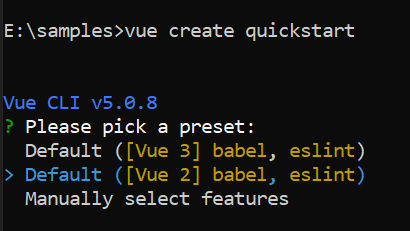Getting Started with the Vue Toolbar Component in Vue 2
25 Apr 20258 minutes to read
This article provides a step-by-step guide for setting up a Vue 2 project using Vue-CLI and integrating the Syncfusion® Vue Toolbar component
Prerequisites
System requirements for Syncfusion® Vue UI components
Dependencies
Install the below required dependency package in order to use the Toolbar component in your application.
|-- @syncfusion/ej2-vue-navigations
|-- @syncfusion/ej2-base
|-- @syncfusion/ej2-vue-base
|-- @syncfusion/ej2-navigations
|-- @syncfusion/ej2-inputs
|-- @syncfusion/ej2-buttonsSetting up the Vue 2 project
To generate a Vue 2 project using Vue-CLI, use the vue create command. Follow these steps to install Vue CLI and create a new project:
npm install -g @vue/cli
vue create quickstart
cd quickstart
npm run serveor
yarn global add @vue/cli
vue create quickstart
cd quickstart
yarn run serveWhen creating a new project, choose the option Default ([Vue 2] babel, eslint) from the menu.

Once the quickstart project is set up with default settings, proceed to add Syncfusion® components to the project.
Add Syncfusion® Vue packages
Syncfusion® packages are available at npmjs.com. To use Vue components, install the required npm package.
This article uses the Vue Toolbar component as an example. Install the @syncfusion/ej2-vue-navigations package by running the following command:
npm install @syncfusion/ej2-vue-navigations --saveor
yarn add @syncfusion/ej2-vue-navigationsImport Syncfusion® CSS styles
You can import themes for the Syncfusion® Vue component in various ways, such as using CSS or SASS styles from npm packages, CDN, CRG and Theme Studio. Refer to themes topic to know more about built-in themes and different ways to refer to themes in a Vue project.
In this article, the Material theme is applied using CSS styles, which are available in installed packages. The necessary Material CSS styles for the Toolbar component and its dependents were imported into the <style> section of src/App.vue file.
<style>
@import "../node_modules/@syncfusion/ej2-base/styles/material.css";
@import "../node_modules/@syncfusion/ej2-buttons/styles/material.css";
@import "../node_modules/@syncfusion/ej2-popups/styles/material.css";
@import "../node_modules/@syncfusion/ej2-vue-navigations/styles/material.css";
</style>Add Syncfusion® Vue component
Follow the below steps to add the Vue Toolbar component:
1. First, import and register the Toolbar component in the script section of the src/App.vue file.
<script>
import { ToolbarComponent, ItemDirective, ItemsDirective } from "@syncfusion/ej2-vue-navigations";
export default {
components: {
'ejs-toolbar': ToolbarComponent,
'e-item': ItemDirective,
'e-items': ItemsDirective
}
}
</script>2) property.
<template>
<div id="app">
<ejs-toolbar >
<e-items>
<e-item text='Cut'></e-item>
<e-item text='Copy'></e-item>
<e-item text='Paste'></e-item>
<e-item type='Separator'></e-item>
<e-item text='Bold'></e-item>
<e-item text='Italic'></e-item>
<e-item text='Underline'></e-item>
</e-items>
</ejs-toolbar>
</div>
</template>Here is the summarized code for the above steps in the src/App.vue file:
<template>
<div id="app">
<div id='container' style="margin:50px auto 0; width:100%;">
<br>
<ejs-toolbar>
<e-items>
<e-item text='Cut'></e-item>
<e-item text='Copy'></e-item>
<e-item text='Paste'></e-item>
<e-item type='Separator'></e-item>
<e-item text='Bold'></e-item>
<e-item text='Italic'></e-item>
<e-item text='Underline'></e-item>
</e-items>
</ejs-toolbar>
</div>
</div>
</template>
<script>
import { ToolbarComponent, ItemDirective, ItemsDirective } from "@syncfusion/ej2-vue-navigations";
export default {
name: "App",
components: {
'ejs-toolbar': ToolbarComponent,
'e-item': ItemDirective,
'e-items': ItemsDirective
}
}
</script>
<style>
@import "../node_modules/@syncfusion/ej2-base/styles/material.css";
@import "../node_modules/@syncfusion/ej2-buttons/styles/material.css";
@import "../node_modules/@syncfusion/ej2-popups/styles/material.css";
@import "../node_modules/@syncfusion/ej2-vue-navigations/styles/material.css";
</style>Run the project
To run the project, use the following command:
npm run serveor
yarn run serveInitialize the Toolbar using HTML elements
The Toolbar component can be rendered based on the given HTML element using <ejs-toolbar>. You need to follow the below structure of HTML elements to render the Toolbar inside the <ejs-toolbar> tag.
<ejs-toolbar> --> Root Toolbar Element
<div> --> Toolbar Items Container
<div> --> Toolbar Item Element
</div>
</div>
</ejs-toolbar>
<template>
<div id="app">
<div id='container' style="margin:50px auto 0; width:100%;">
<br>
<ejs-toolbar>
<div>
<div><button class="e-btn e-tbar-btn">Cut</button></div>
<div><button class="e-btn e-tbar-btn">Copy</button></div>
<div><button class="e-btn e-tbar-btn">Paste</button></div>
<div class="e-separator"></div>
<div><button class="e-btn e-tbar-btn">Bold</button></div>
<div><button class="e-btn e-tbar-btn">Italic</button></div>
</div>
</ejs-toolbar>
</div>
</div>
</template>
<script>
import { ToolbarComponent } from "@syncfusion/ej2-vue-navigations";
export default {
name: "App",
components: {
'ejs-toolbar': ToolbarComponent
}
}
</script>
<style>
@import "../node_modules/@syncfusion/ej2-base/styles/material.css";
@import "../node_modules/@syncfusion/ej2-buttons/styles/material.css";
@import "../node_modules/@syncfusion/ej2-popups/styles/material.css";
@import "../node_modules/@syncfusion/ej2-vue-navigations/styles/material.css";
</style>. In the template section, define the Toolbar component with text
See Also
NOTE
You can refer to our Vue Toolbar feature tour page for its groundbreaking feature representations. You can also explore our Vue Toolbar example that shows you how to render the Toolbar in Vue.